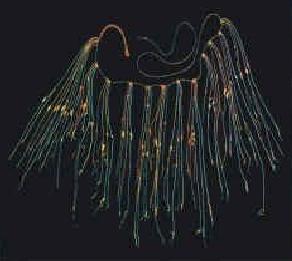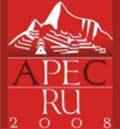United Kingdom
| Welcome |
| Peru in Brief |
| History |
| Geography |
| Government & Politics |
| Maritime delimitation between Peru and Chile |
| News |
Links |
| THE QUIPUS | ||
The quipu ("knot" or "counting by knots") was a mnemonic device employed by the Incas for reckoning tributes, keeping demographic records and registering events from the past as well as accounts relating to laws, edicts, rites and ceremonies. This is Garcilaso's description of the quipus carried by the natives on his father's encomienda as they made their way to Cuzco to pay thehir tributes: "The Indians made strings of various colours. Some were all of one colour, others of two combined, others of three, others more; and these colours, whether single or combined, all had a meaning. The strings were closely laid up in three or four strands, about the girth of an iron spindle, and three quarters of a vara long. They were strung on a thicker cord, from which they hung in the manner of a fringe. The thing to which a string referred was understood by its colour: for instance, a yellow string referred to gold, a white one to silver and a red one to soldiers. Things which had no colour were arranged according to their importance, beginning with that of most consequence, and proceeding in order to the most insignificant; each under its generic head, such as the different kinds of grain under corn, and the pulses in the same way. Some of these strings had other finer ones of the same colour attached to them, to serve as supplements or exceptions to the chief record. |
||
 |
||
Thus, if the main string of men of a certain age had reference to the married people, the supplementary string gave the number of widowers of the same age in that year. For these accounts were made up annually, and only related to one year. The Knots indicated units, tens, hundreds, thousands, and tens of thousands, but they rarely or never went beyond that; because each village was taken by itself, and each district, and neither ever reached to a number beyond tens of thousands, though there were plenty within that limit." Quipus had once been stored in Cuzco , but most were destroyed by the generals under Atahualpa , who after unleashing their fury on the lineage of Huascar proceeded to obliterate all records of the latter's deeds. The destruction was completed by colonial officials appointed for the task by the viceroy Francisco de Toledo , in order that any practices apt to arouse the natives' affection for the ways of their ancestors might be eradicated. Quipu storehouses in the provinces were guarded by local chiefs or by the priests attending to the funeral grounds - until their contents fuelled the bonfires lit by those who would root out idolatry and anything connected with ancient native beliefs and forms of worship. Eventually, knowledge of the meanings associated with quipu knots and coloured strings was lost with the passing of the quipucamayoc elders (though some of these had been questioned personally by chroniclers or by officials under the orders of colonial rulers such as Vaca de Castro or Toledo). What few quipus are preserved today have mostly come from digs around burial sites. (from The Encyclopaedic Dictionary of Peru, by Alberto Tauro del Pino) |
||
| <BACK> |





